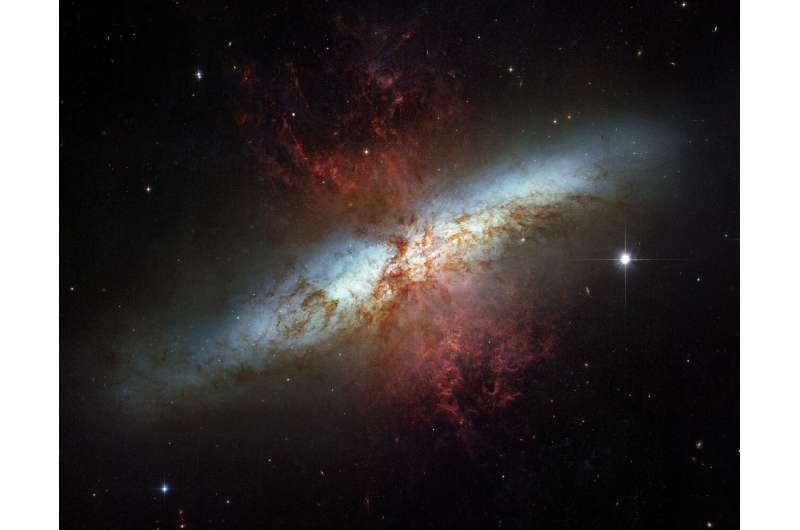A Hubble image of the starburst galaxy M82. Astronomers have concluded that during the early universe, the reionization of the gas in the intergalactic medium was probably done by ultraviolet light emitted by the star formation in very massive starburst galaxies. Credit: NASA, ESA and the Hubble Heritage Team; STScI/AURA
The sparsely distributed hot gas found today between galaxies, the intergalactic medium (IGM), is ionized. The early universe started off hot, but then it rapidly expanded and cooled allowing its main constituent, hydrogen, to combine to form neutral atoms. When and how did these neutral atoms become reionized to compose the IGM we see today? Astronomers think that ultraviolet radiation emitted by massive young stars did this work once stars began to form and shine during the cosmic era named after this activity, the "era of reionization."
One of the key steps in the reionizing of the IGM it the ultraviolet radiation's escape from galaxies into the IGM, but this is not well understood. Astronomers know only that it would have had to have been efficient because only if the fraction escaping were high enough could starlight have done the job. Star forming galaxies, however, are rich in dense molecular gas and dust, and that dust also absorbs much of the UV radiation. That suggests that some other significant source of ionizing radiation is required, and speculation has included the possible existence of exotic objects like faint quasars, X-ray binary stars, or perhaps even decaying/annihilating particles. There is, however, little evidence so far that any of these are abundant enough or capable of doing the job.
CfA astronomers Rohan Naidu, Sandro Tacchella, Charlotte Mason, Sownak Bose, and Charlie Conroy led an effort to better estimate the most uncertain parameter in this puzzle (and the one most difficult to measure directly): the escape fraction of ionizing photons. They compare measurements and models of the two other key processes involved, the star formation rate in galaxies and the number of UV photons produced. They apply these to constrain what the escape fraction would have to have been in order to make the modeling consistent. The measurements are uncontroversial, but the models differ and the scientists selected from two types: those in which the escape fraction is constant during the epoch of reionization and those in which it depends on the star formation rate.
The astronomers reach several important conclusions. The escape fraction (at least for bright galaxies) needs to be about 20% in the early universe, about twice as much as had been previously obtained. They argue this might happen because concentrated regions of star formation can blow channels through which the UV light escapes. Using cosmological simulations, they also find that in only three hundred million years the young universe goes from being 90% neutral gas to being only 10% neutral. Not least, they conclude that most of the reionization was done by a small number of the most massive and luminous galaxies which they call "oligarchs." Previous studies had suggested that there was a large population of faint galaxies that could do the trick, but the new results disagree, concluding that such a population would have already been detected.
More information: Rohan P. Naidu et al. Rapid Reionization by the Oligarchs: The Case for Massive, UV-bright, Star-forming Galaxies with High Escape Fractions, The Astrophysical Journal (2020). DOI: 10.3847/1538-4357/ab7cc9
Journal information: Astrophysical Journal
Provided by Harvard-Smithsonian Center for Astrophysics
























